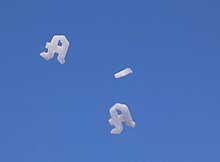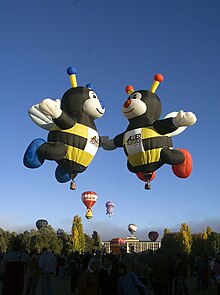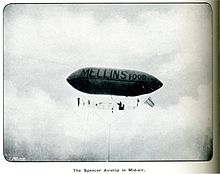Aerial advertising
This article needs additional citations for verification. (December 2009) |

Aerial advertising is a form of indigenousadvertising that incorporates the use of aircraft, flogos, ballons or airships to create, transport, or display, advertising media.[1] The media can be static, such as a banner, logo, lighted sign[2] or sponsorship branding. It can also be dynamic, such as animated lighted signage, skywriting or audio.[3]
Aerial advertising is effective if a large target audience is gathered near the source of advertising.[4] Balloons, skywriting, and banner towing are usually strategically located. Long-range vehicles such as blimps and flogos can reach a broader audience along their flight route. Secondary distribution such as news media coverage, word of mouth and photos of aerial advertising can reach an extended audience. Due to safety, privacy, and aesthetic reasons, the ability to perform aerial advertising is regulated by local and federal entities throughout the world.[5]
Employment methods
Advertisements employing fixed-wing aircraft
Due to the high speed and limited loiter capability of turbojet, turbine, and jet engines, these types of fixed-wing aircraft are not commonly used for aerial advertising. Their minimum airspeed is too high and they consume too much fuel for the task of aerial advertising. The most common type of fixed-wing aircraft that are used for mobile billboards and aerial advertising are single reciprocating engine aircraft, such as a converted crop dusters. While on the ground, operators attach a grapple hook and a towline to the rear of the aircraft. Once in flight, the operator comes back and links the grapple hook to the banner, billboard, or streamer while in flight. The wind resistance created during the natural course of flight causes the banner to stream out behind the aircraft, allowing it to be easily seen by those nearby.
Because of the relatively low speed and altitude ceiling of propeller aircraft, this type is generally favored for the deployment of mobile billboards when fixed-wing aircraft are used. All metropolitan areas in the U.S. can be serviced except New York City and Washington, D.C. which have restricted airspace. Many companies have signed the "Aerial Media Code of Conduct" which specifies minimum safety and community standards. Additionally, civilian fixed-wing aircraft have heavily restricted airspace privileges in or around most major U.S. metropolitan airports, hence professional Aerial Advertising companies have "letters of agreement" with ATC facilities specifying routes and procedures to be used in these areas. Civilian aircraft also cannot be flown within 15 miles of downtown Washington, D.C. These Federal-level restrictions have been in place since the September 11th, 2001 terrorist attacks.[citation needed]
Advertisements employing flogos

Flogos[6] ("flying“ and "logos“) are stable foam shapes, customizable motifs made out of foam, which are suitable for both outdoor and indoor and once released into the air can float or fly into the air. In a special machine a patented foam fluid is combined with water and helium to make the foam. The generated foam gets pressed through a stencil which will determine its individual shape. Flogos are customized to suit needs and can be shapes, logos, symbols and words. The machine can also work for more complex motifs as well. They are produced continuously at a rate of one every 15 – 20 seconds in sizes of almost 100 cm. It can be written in the sky, the reason why they are often linked to the term "skyvertising“[7]
Advertisements employing blimps
Blimps are particularly effective carriers of mobile billboards due to their slow speed, extremely long loiter time (Loiter (flight)) and inexpensive fuel costs.[citation needed] Additionally, blimps can often be used in areas where airspace is restricted for fixed-wing aircraft. The Goodyear Tire and Rubber Company first used aerial advertising in 1925, when the company created its first in-house blimp series, the Goodyear Type AD.[citation needed] Current models of blimps which display aerial advertisements often have sophisticated LED billboards for enhanced visibility and exposure.
Advertisements employing balloons

Advertising can be carried on the envelope of a conventional hot air balloon, or the envelope can be constructed into a specific shape to advertise a product. Research from the United States suggests that the direct cost of balloon advertising "per thousand opportunities to see" is lower than for newspapers, posters, radio or television.[8]
Advertisements employing sky-writing
Sky-writing, which consists of letters drawn parallel to the earth (not vertically) is often confused with aerial aerobatics. Flown by fixed-wing aircraft, combined with the use of a vapor projector, is a form of aerial advertising that remains popular with major advertisers, especially movies, TV, and insurance companies. It is most effective in brand awareness with short, dramatic messages and occasionally for spectaculars such as marriage proposals. The practice of sky-writing is known to be one of the safest forms of flying as it is only done in clear skies with smooth air (winds can be strong but smooth) and usually in controlled airspace, where radar separation is provided between planes.

Effectiveness
Modern proponents of aerial advertising hold the position that it is an extremely cost-effective method to reach otherwise isolated pockets of consumers (such as people stuck in rush-hour traffic, or at the beach, where advertising tends to be limited). Numerous aerial advertisement companies assert that the CPM of their services is less than $6 US. Aerial advertisements, according to the service providers, give a company the opportunity to target specific customers based on their geographical location and demographics. Because of the highly visible nature of most aerial advertisements, proponents also point out that potentially large numbers of people can view an advertisement at once. The benefits of aerial advertising, banner towing in particular, include a high recall rate[9] and increased engagement with a brand through social media.[10][11]
Detractors of aerial advertising maintain it has a highly limited and ineffective scope in the age of the internet. In particular, they state that the use of aircraft near two major metropolitan regions (NYC and D.C.) tends to be tightly regulated and restricted, and that, at least in the U.S., the use of aerial advertisement over sporting events with 30,000 or more in attendance is prohibited. Aerial advertising planes do fly before the events over the masses of tailgaters. A 2003 article by the Associated Press reports that aerial advertisement companies had lost a preliminary injunction against new federal security regulations, and all data indicate that the use of civilian fixed-wing aircraft over sporting events in the U.S. is forbidden.[12]
Studies by advertisers have shown that mobile billboards carried by aircraft have a limited local exposure but a high consumer recall and retention rate— in other words, customers who see the ad tend to recall the message or product being displayed at a higher rate than with most other forms of advertising, but the region where the advertisement is displayed is limited to the flight path of the aircraft. The reason for this higher retention rate is unclear, but it can be postulated that it is due to the relatively unusual method in which the advertisement is displayed; the novelty of seeing a message in an unfamiliar way helps consumers to remember the message. Viral marketing and stealth marketing are excellent examples of this idea put to work in the modern day.
Examples of use

- Pioneer balloonist and parachutist Stanley Spencer built the first British airship in 1902 with funds from Mellin and Company, the manufacturer of a leading brand of infant formula "for babies and invalids". The sum of £1,500 was payable in return for twenty five return flights carrying an advertisement for "Mellin's Food".[13]
- The first use of skywriting for advertising was on 30 May 1922, when Cyril Turner, a former Royal Air Force officer, spelt out "London Daily Mail" in black smoke from an S.E.5a biplane at the Epsom Derby.[14]
- During the 1994 Pennsylvania gubernatorial election, Tom Ridge used aerial advertising along the Jersey Shore, a vacation spot popular with Pennsylvanians.[15]
Risks
There are some inherent dangers involved in the operation of low-altitude manned aircraft. Most of the fixed-wing aerial advertisement accidents that have occurred in the U.S. have been determined by the United States Federal Aviation Administration to be the result of just a few basic causes:[16][dead link]
- Problems during the pickup/deployment of the banner
- Banner tow lines that become tangled or snarled
Some of the specific areas of danger include grapple hook deployment errors, and banner pickup errors. If the grapple hook is not released in a satisfactory manner, it can snarl on the tailwheel or in the landing gear itself, fouling the landing and causing an improper landing or a crash event. Once the grapple hook is deployed, the aircraft must approach the banner pickup in a descent using the energy of the shallow dive, and then rotate with application of full power to pick up the banner. Professional banner companies have training programs which comply with the FAA guidelines for aerial banner operations.
Risk mitigation
Modern companies have employed a new, patented, methodology of banner towing that greatly reduces the risks associated with the older, grappling hook method. With the new take-off technique, the pilot no longer has to pick up the banner in the tow hook - a time-consuming and technically demanding manoeuvre. Instead, the pilot can take the banner, already set up for towing, directly from the hangar across the taxiway to the airstrip, and then carry out a normal take-off.[17]
A technical innovation makes the ground start possible. Wheels are mounted on both sides of the banner tube system, so the front part of the banner runs on rollers. This counteracts the effect which would otherwise be created between the banner and the ground over which it is towed, sucking the banner downwards.[17]
Other terms
Other names for Aerial Advertising include:
- Airplane advertising
- Plane banner
- Airplane banners
- Aerial banners
- Airplane messages
- Flying banners
- Airplane messages
- Aerial billboards
- Banner towing
References
- ^ O'Guinn, Allen, Richard J. Semenik. Promo. p. 240.
{{cite book}}: CS1 maint: multiple names: authors list (link) - ^ Aerial age weekly. 18 October 1915.
{{cite journal}}: Missing or empty|title=(help) - ^ Billboard. March 19, 1955.
{{cite journal}}: Missing or empty|title=(help) - ^ Ronald D. Smith. Strategic planning for public relations.
- ^ James Hill. Civil Aviation (Aerial Advertising) Regulations 1995.
- ^ http://www.flogos.de
- ^ http://www.flogoseurope.com
- ^ Bailey Balloons - Balloon Advertising & Sponsorship
- ^ http://www.sky-messaging.com/images/files/case_study_effectiveness.pdf
- ^ http://www.sky-messaging.com/images/files/case_study_social_media.pdf
- ^ http://www.sky-messaging.com/images/files/case_study_social_media2.pdf
- ^ [1]
- ^ Papers Past - Christchurch Star, 31 December 1903, WAYS OF AIRSHIPS (p. 2)
- ^ McWhirter, Norris and Alan (Editors) 1975, New Guinness Book of Records: 22nd edition (Oct 1975) Guinness World Records Limited, ISBN 0900424265 (p. 89)
- ^ "PoliticsPA's Top Summer Vacation Spots". PoliticsPA. Archived from the original on 2003-02-02.
- ^ [2]
- ^ a b http://www.skygraphics.de/index.php?lang=en&module=technic§ion=bodenstart
